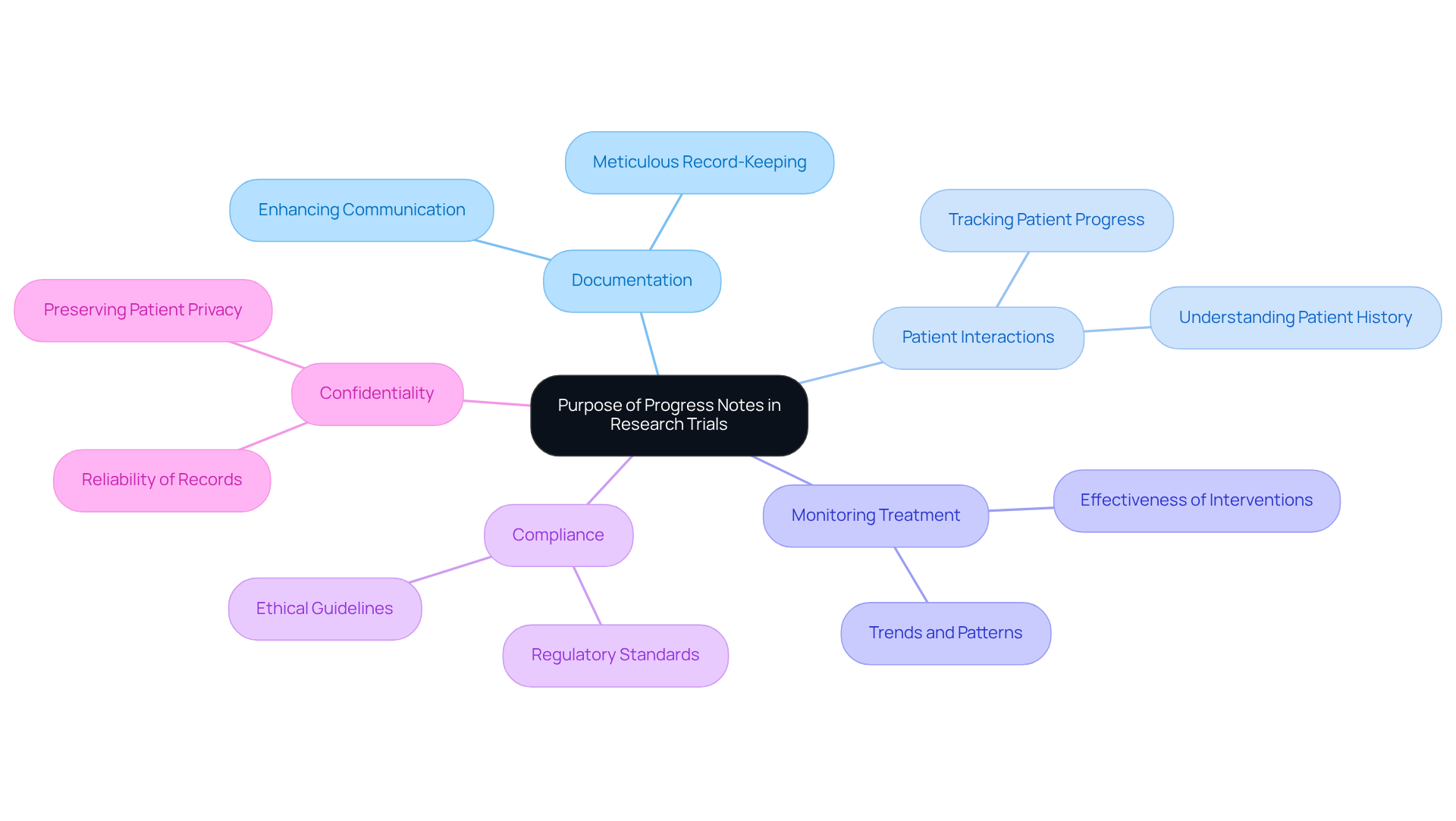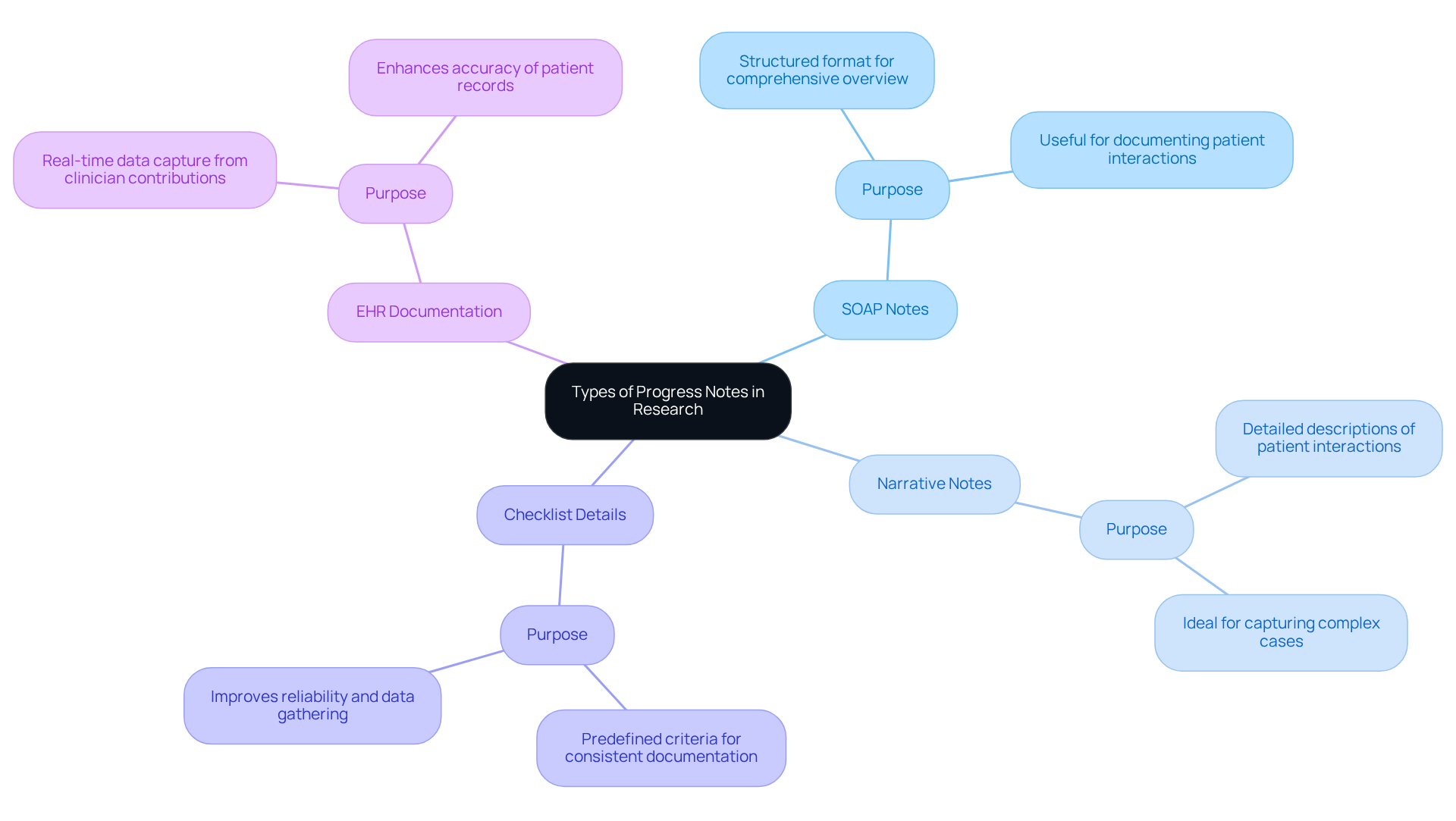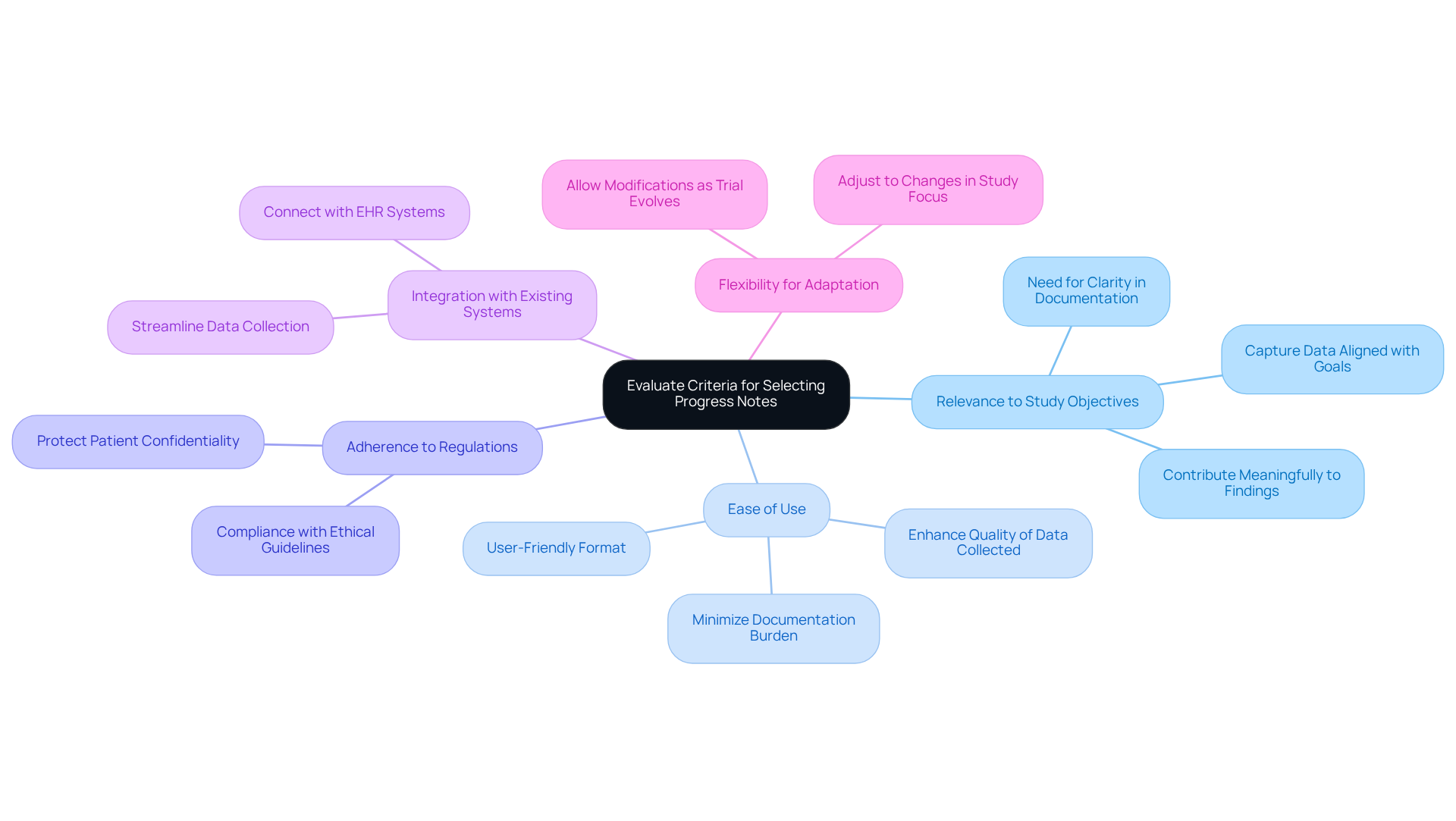Overview
This article addresses the emotional challenges healthcare providers face when selecting types of progress notes for research trials. Proper documentation is crucial, not only for enhancing patient care but also for upholding the integrity of studies. Have you ever felt overwhelmed by the administrative burdens that come with documentation? You’re not alone.
The article outlines various types of progress notes, such as SOAP notes and EHR documentation, evaluating criteria for selection. It highlights the importance of:
- Relevance to study objectives
- Ease of use
- Adherence to regulations
This comprehensive framework aims to support researchers in improving their documentation practices, ultimately benefiting patient care.
By understanding and addressing these challenges, we can foster a more compassionate approach to documentation. Let’s work together to simplify the process and enhance the quality of care we provide. Your commitment to proper documentation can make a significant difference in the lives of patients and the success of research trials.
Introduction
In the intricate landscape of research trials, the significance of progress notes cannot be overstated. These vital records not only document patient interactions and treatment responses but also serve as a linchpin for effective communication among research teams.
Have you ever felt overwhelmed by the sheer volume of documentation required? By exploring the various types of progress notes available, researchers can streamline their documentation processes, ultimately enhancing the quality of patient care and study outcomes.
Yet, with so many options and criteria to consider, how can one navigate the complexities of selecting the most suitable progress notes that align with both research objectives and regulatory standards?
Let's delve into this together.
Understand the Purpose of Progress Notes in Research Trials
In studies, progress records are essential as they help select the types of progress notes used in research trials to document patient interactions, treatment responses, and changes in condition over time. Have you ever felt overwhelmed by the administrative burdens that can affect patient care? These records not only assist in monitoring the effectiveness of interventions but also enhance communication among the study team, enabling them to select the types of progress notes used in research trials and ensure compliance with protocols.
By understanding the purpose of these annotations, researchers can guarantee the collection of crucial information that upholds the integrity and validity of study results. Imagine recognizing trends and patterns that may emerge during the study—this insight is essential for future investigations and clinical applications. A case study emphasizes that dependable records not only help in adhering to regulatory standards but also improve the overall quality of study outcomes.
It's significant to note that merely 5 out of 1,000 records included PHI, showcasing the reliability of these records in preserving patient confidentiality while documenting vital information. As the saying goes, 'if it wasn’t documented, it didn’t happen.' This highlights the necessity of meticulous record-keeping in studies. Moreover, organized recording of updates is essential as it helps to select the types of progress notes used in research trials, which is crucial for ensuring patient safety and upholding study integrity.
In light of these points, let us commit to fostering an environment where careful documentation is prioritized. Together, we can enhance patient care and contribute to the success of our studies.

Identify Different Types of Progress Notes Used in Research
In research trials, healthcare providers often face emotional challenges related to documentation. The administrative burdens can impact patient care significantly. Understanding how to navigate these challenges is crucial, and several types of progress notes can help ease this process, each serving distinct purposes:
-
SOAP Notes: This structured format comprises four sections—Subjective, Objective, Assessment, and Plan—offering a comprehensive overview of patient status and treatment strategies. SOAP records are especially useful in clinical research for documenting patient interactions and directing care decisions.
-
Narrative Notes: These free-text entries allow for detailed descriptions of patient interactions and observations, making them ideal for capturing complex cases where nuances are critical. Narrative records offer flexibility in documentation, accommodating the distinct features of each patient encounter.
-
Checklist Details: Utilizing predefined criteria, checklist details ensure that all necessary information is consistently documented. This organized method improves reliability and aids in comprehensive data gathering across entries, making it especially beneficial in settings where standardization is essential.
-
Electronic Health Record (EHR) Documentation: Numerous studies utilize EHR systems that automatically create updates based on clinician contributions. This real-time data capture streamlines documentation processes and enhances the accuracy of patient records.
By comprehending these diverse categories of documentation, researchers can select the types of progress notes used in research trials that best fit their study design and data gathering needs. Embracing these tools can alleviate some of the burdens healthcare providers face, ultimately leading to improved patient care and outcomes.

Evaluate Criteria for Selecting Progress Notes
It is crucial to select the types of progress notes used in research trials while considering several key criteria that can significantly impact both the research and patient care.
-
Relevance to Study Objectives: It's vital that the selected type of record effectively captures data aligned with the project's goals. Every entry should contribute meaningfully to the findings. A systematic review highlighted that only three studies explicitly mentioned their selection criteria for quotations, emphasizing the need for clarity in documentation practices.
-
Ease of Use: Opt for a user-friendly format that minimizes the documentation burden on clinicians. This not only saves time but also enhances the quality of data collected, allowing providers to focus more on patient care. A study discovered that experiments using organized update records indicated enhanced results, showcasing the considerable influence of careful documentation methods on study effectiveness.
-
Adherence to Regulations: Ensure that the chosen materials adhere to ethical guidelines and regulatory standards, such as HIPAA, to protect patient confidentiality and maintain the integrity of the research.
-
Integration with Existing Systems: Evaluate how well the progress notes can connect with existing electronic health record (EHR) systems or other data management tools employed in the study. Seamless integration can streamline data collection and analysis processes.
-
Flexibility for Adaptation: Choose a format that allows for modifications as the trial evolves. This flexibility is essential for adjusting to changes in study focus or patient needs, ensuring that the documentation remains pertinent throughout the investigation.
Incorporating expert insights, Meri Beckwith emphasizes that "strong statistics ensure that results are not only due to chance but reflect real clinical impacts." This underscores the importance of accurate documentation in achieving reliable research outcomes.
By thoroughly evaluating these criteria, researchers can select the types of progress notes used in research trials to enhance the efficiency of their trials while also upholding the integrity of the data collected. Remember, the right tools can make a significant difference, allowing you to focus on what truly matters—providing the best care for your patients.

Conclusion
Selecting the appropriate types of progress notes for research trials is crucial for ensuring both the quality of patient care and the integrity of study results. These notes are the backbone of documentation, providing essential insights into patient interactions, treatment responses, and overall progress throughout the trial. Have you ever considered how effective documentation practices can enhance the reliability and validity of your findings? By understanding their purpose, researchers can significantly improve their approach to patient care.
The article outlines various types of progress notes, including:
- SOAP notes
- Narrative notes
- Checklist details
- EHR documentation
Each format offers unique advantages that cater to different aspects of patient care and data collection. When selecting these notes, it’s important to consider factors such as:
- Relevance to study objectives
- Ease of use
- Adherence to regulations
- Integration capabilities
- Flexibility
How can evaluating these factors help streamline your documentation efforts? By focusing on these criteria, researchers can deliver optimal patient care.
Ultimately, the significance of meticulous record-keeping in research trials cannot be overstated. As the landscape of clinical research continues to evolve, prioritizing accurate and organized documentation will enhance study outcomes and foster a culture of accountability and excellence in patient care. By committing to these best practices, researchers can contribute to the advancement of medical knowledge and improve the overall quality of healthcare. Together, let’s embrace these solutions to support one another in our shared mission to provide the best care possible.




